
Asya Agulnik, MD, MPH, and Wojciech Mlynarski, MD
When Russian forces invaded Ukraine in February 2022, disruptions in civilian life (particularly to the healthcare system) created a dire situation for Ukrainian children with cancer and blood disorders. In response, the St. Jude Global initiative of St. Jude Children's Research Hospital banded together with many international partners and formed Supporting Action for Emergency Response in Ukraine (SAFER Ukraine). An account of SAFER Ukraine appears today in The Lancet Haematology.
SAFER Ukraine partners include non-governmental organizations (NGOs) or foundations such as Fundacja Herosi and Tabletochki Charity Foundation, the Polish Society of Pediatric Oncology and Hematology (PSPOH), the International Society for Pediatric Oncology-Europe, Childhood Cancer International-Europe and government agencies plus many other volunteers and contributors. The effort facilitated the safe evacuation of more than 900 patients and families to reestablish medical care abroad.
"SAFER Ukraine demonstrates the importance of collaborative networks in global health, with participation from individuals, institutions and governments, to facilitate both rapid responses to emergencies and ongoing capacity building to improve patient care and outcomes," said first and co-corresponding author Asya Agulnik, M.D., M.P.H., St. Jude Department of Global Pediatric Medicine, St. Jude Global Euro Regional Program director and St. Jude Global Critical Care Program director.
A model for international cooperation
The SAFER Ukraine effort provides a proof-of-concept for global health that can be leveraged in future international emergency responses. There were several unique and notable characteristics of SAFER Ukraine that helped the effort be successful. These factors include the patient population, geopolitical context and well-established pre-war collaborations.
For example, childhood cancer treatment can be effective but requires precise timing. Patients whose care was interrupted can benefit from a rapid evacuation and relocation to a hospital where they can continue their care. If performed quickly, these patients can receive a substantial survival benefit. The war also galvanized support for Ukraine, with the European Union extending immediate protection and legal status to Ukrainian refugees. That status created the legal and financial framework that ultimately made it possible to refer patients throughout Europe for care. Additionally, St. Jude Global already had partnerships in the region. The rapid repurposing of existing collaborative networks was key to the effort's success.
"For me, SAFER Ukraine is a long-continuing journey giving me the opportunity to meet many people around the world who are focused on helping Ukrainian children through their two combats, a cancer and the military violence in their country," said co-corresponding author Wojciech Mlynarski, M.D., Ph.D., Medical University of Lodz, Poland. "Many of these people have become my new reliable friends.
"This paper describing SAFER Ukraine opens a pathway for future collaborative projects, with St. Jude and other international partners," he added.
SAFER Ukraine Process
As of May 2022, 949 patients had arrived at referral hospitals. After the first 12 weeks of war, the volume of patients requesting evacuation decreased; however, SAFER Ukraine continues to support an average of one to two evacuation requests per week.
Ukrainian patients and families needing evacuation were identified through the Tabletochki Foundation or the PSPOH hotline. Patients were transported to the Western Ukrainian Specialized Children's Medical Center in Lviv, Ukraine, where they are stabilized for transfer abroad.
In the first 12 weeks of the war, more than 10 million refugees fled Ukraine. Approximately 50% of those fleeing went to Poland. The number of patients in need triggered concerns that the Polish medical system would be overwhelmed. To mitigate this risk, SAFER Ukraine worked with the Herosi Foundation and the PSPOH to establish the Unicorn Marian Wilemski Clinic, a patient triage center in South-Eastern Poland.
At the clinic, patients were evaluated upon arrival. High-risk or acutely ill patients were transferred immediately to local hospitals, while stable patients remained at the clinic for referral abroad. The clinic provided interpreters, volunteers and patient liaisons to support the psychosocial needs of patients and families.
SAFER Ukraine partnered with hospitals and foundations around the world that provided transportation, covered the cost of medical care and ensured access to psychosocial services. SAFER Ukraine also created a 24-hour/7-days-per-week virtual command center staffed by St. Jude employees and more than 400 international volunteers to support evacuation logistics, including the translation of medical records.
"We hope that lessons learned from SAFER Ukraine can guide future emergency responses to support medically complex, high-risk patients during man-made and natural disasters," Agulnik said. "This effort truly highlighted the importance of our pre-war collaborations. Without the existing and ongoing work with our partners through the St. Jude Global initiative and the St. Jude Global Alliance, this wouldn't have been possible. The supportive geopolitical environment in Europe and the unique patient population of children with cancer were also important factors in the success of SAFER Ukraine."
Authors and funding
The study's other authors are Roman Kizyma, Western Ukrainian Specialized Children's Medical Center; Aleksandra Oszer, Medical University of Lodz; Yuliya Nogovitsyna, Tabletochki Charity Foundation; Malgorzata Dutkiewicz, Fundacja Herosi; Jean Hugues Dalle, Gustave Roussy Cancer Campus; Uta Dirksen, University Hospital Essen; Angelika Eggert, Charite Medical School, Berlin; Ana Fernandez-Teijeiro, Hospital Universitario Virgen Macarena, Seville; Jeanette Greiner, Hospital of Eastern Switzerland; Kathelijne Kraal, Princess Maxima Centre for Pediatric Oncology; Alexandra Mueller, University Medical Center Freiburg; Lucie Sramkova, 2nd Medical School and University Hospital Motol Prague; Marco Zecca, Fondazione IRCCS Policlinico San Matteo; Paul Wise, Stanford University School of Medicine; and Marta Salek, Marcin Wlodarski, Mikhail Pogorelyy and Taisiya Yakimkova of St. Jude.
The authors represent the larger SAFER Ukraine Collaborative which includes over 200 individuals from a variety of organizations and institutions who contributed to the effort.
The Lancet Haematology report was supported in part by ALSAC, the fundraising and awareness organization of St. Jude, among others.
Read the full text of the Lancet Haematology article:
Global effort to evacuate Ukrainian children with cancer and blood disorders affected by war
The Lancet Haematology, published August 30, 2022






